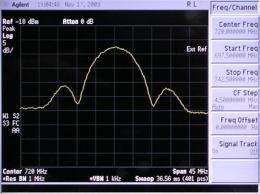SMOS satellite instrument comes alive (w/ Video)

The MIRAS instrument on ESA's SMOS satellite, launched earlier this month, has been switched on and is operating normally. MIRAS will map soil moisture and ocean salinity to improve our understanding of the role these two key variables play in regulating Earth's water cycle.
"Following the switch-on, MIRAS is working beautifully well with all key subsystems, including all of the receivers, the optical fibres and the correlator unit, in perfect functioning condition," said ESA's Manuel Martin-Neira, SMOS Instrument Principal Engineer. "We have been able to produce reasonable test data even without in-orbit calibration."
MIRAS (Microwave Imaging Radiometer using Aperture Synthesis) is an L-band radiometer with 69 receivers mounted on three deployed arms to measure the radiation coming from Earth.
In order to measure accurately, the receivers must be within a +/-3°C temperature range of each other, with the optimal operating temperature at 22°C. Heaters are installed on the satellite to achieve the temperature needed.
Switching on the instrument begins with activating the central payload computer, which controls many of the instrument's subsystems and gives instructions to the distributed command and monitoring modes on each arm.
To assess the electrical performance of the instrument after switch-on while limiting the consumption of heater power, the physical temperature for start up was set to 10°C.
"The active thermal control is now in operation and is keeping the instrument well within the expected temperature range," Mr Martin-Neira said. "Tomorrow we expect to assess the payload at the final 22°C temperature."
The central payload computer also controls the 'mass memory', which collects all the science data from the receivers and sends them to receiving stations on the ground. The high-speed downlink, which transmits the data to the ground station, was switched on, and data have been transmitted to ESA's European Space Astronomy Centre (ESAC), in Villafranca, Spain. The data acquisition and processing systems located at ESAC are also working well, and the first test of the product generation system has been successful.
"With the critical launch and early orbit phase completed, the engineers can now evaluate the quality of the downlinks and concentrate on the calibration of the instrument," SMOS Project Manager Achim Hahne said.
Data provided by MIRAS will be important for weather and climate modelling, water resource management, agriculture planning, ocean currents and circulation studies and forecasting hazardous events such as floods.
"We are very happy that we have received the first data from MIRAS, which we expect to make very strong contributions to scientists' understanding of Earth's water cycle," said Guillermo Buenadicha, SMOS Payload Operations Engineer at ESAC.
"We are now looking forward to analysing the first data and to start testing the processing systems in the ground station," SMOS Mission Manager Susanne Mecklenburg said.
The SMOS (Soil Moisture and Ocean Salinity) Earth Explorer satellite and ESA's Proba-2 were launched into orbit together from the Plesetsk Cosmodrome in northern Russia on 2 November.
Source: European Space Agency


















